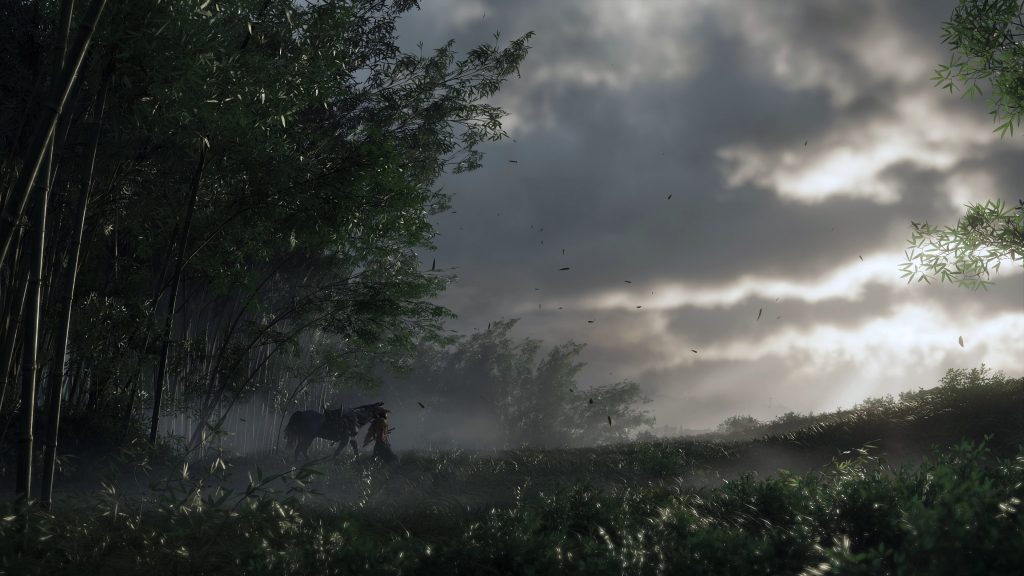Sony’s Ghost of Tsushima received a major update during last week’s State of Play event. We got a huge 18 minutes of footage, with the emphasis on open-world exploration, combat, and customization options. (You can check our take from this extended reveal here)
Now what caught my attention (and many others in this regard as well) was the open-world, which as many of us suspected earlier, seems very ‘similar’ in terms of its basic functionalities.
As far as we have seen, Ghost of Tsushima will feature a lush open-world environment that players can explore on a horseback.
The latest gameplay footage also gave us a tiny glimpse of what to expect, which includes chasing “?” marks like the ones seen in the recent Assassin’s Creed titles or The Witcher 3: Wild Hunt.
There have always been debates going around as to what makes an open-world game immersive so that players can lose themselves for hundreds and hundreds of hours.
Some believe that it’s the visual cues that make the world feel believable and alive and in result immersive, others feel that more objects or things to interact with every few seconds is the more prominent way to make an open-world immersive.
Ghost of Tsushima, as of now has given us an indication that it falls in the latter category. There are outposts to clear, collectibles to be found, NPCs to interact with, and so forth. Now, none of this is a new addition to the basic template of the open-world games we have seen and learned to expect in this console generation. But then how will Sucker Punch’s Ghost of Tsushima differentiate itself from other open-world titles we have already spent hundreds or thousands of hours in?
Ghost of Tsushima’s world can only be different if it’s grounded in its expectations and if and only if its open-world is contextualized. To elaborate on this, I would like to draw your attention to a term called the “40 seconds open-world rule.”
Luke Stephens, ( A YouTuber I personally like for his analytical and narcissistic take on everything) made a video last year, talking about this very subject. According to that video, every open-world follows this “40 seconds rule” after which the player stumbles upon something to interact within the game.
That “something” can be anything, whether it’s an NPC, a side quest, or a hidden cave. But this is how most open-world works, or let’s say it’s the benchmark. If we look at the open-world of Horizon Zero Dawn, Days Gone, and any recent Ubisoft open-world titles, they all follow this rule.
Now, Luke also talked about how 2018’s Red Dead Redemption 2 defies this rule and makes its own path to make its open-world different and immersive. That was only possible by having a grounded approach and a world that felt contextualized.
Red Dead Redemption 2 had a melancholic flavor, in contrast to 2010’s Red Dead Redemption whose world had a more pleasant vibe. Now, to make its open-world more believable, Rockstar Games’ pushed that 40 seconds boundary to a sixty or sometimes eighty seconds one before you could interact with anything in the game.
Why they did something like that, rather than filling the world with things to interact with every 40 seconds, was because it fits much better with the game’s vision and theme. Rockstar Games wanted players to feel lonely during the time they traversed Red Dead Redemption 2’s gorgeous yet relatively empty open-world.
They wanted players to appreciate the beauty and the wildlife of that specific age in time, which was a character on its own. Moreover, even when you found something to interact within the game, let’s say, a cave hidden behind a waterfall, the loot you found there was something that fit in with the game’s context and felt believable.
In short, if you found a hat behind a waterfall, there was a reason as to why it was it there. As a result, it made the game’s open-world feel more authentic than most of the other titles in the genre. It also made it feel more alive.
Hideo Kojima’s post-dystopian social commentary about solitude and human connections in Death Stranding felt genuinely implemented in its open-world as well. It was empty for a reason and the little things we did interact along the way were there for an even better reason.
Games like Assassin’s Creed Origins/Odyssey or even Sony’s very own Horizon Zero Dawn seems to drift away from this grounded approach. In Origins, you can find a weapon in a chest in a lion’s cave for some reason. Get my point?
Even Red Dead Redemption 2 offers a plethora of collectibles to find throughout its massive open-world. But rarely any of them feels out of the world or just being there for the sake of adding more numbers of hours to the gameplay. It gives players a good reason to chase after these mysterious objects. Having a checklist of things to do isn’t bad if it syncs with the game’s environments.
Tsushima is a sprawling real-life Japanese island, full of lush forests and mountain passes. The island is about 41 square miles. Relatively smaller to make an open-world game out of in 2020.
But bigger isn’t necessarily better. If Sucker Punch manages to capture the authenticity of the island, and implement it in a way that makes its open-world feels grounded and contextualized, it will give players a substantial reason to find that one last collectible to add in their collection or clear out another outpost.
